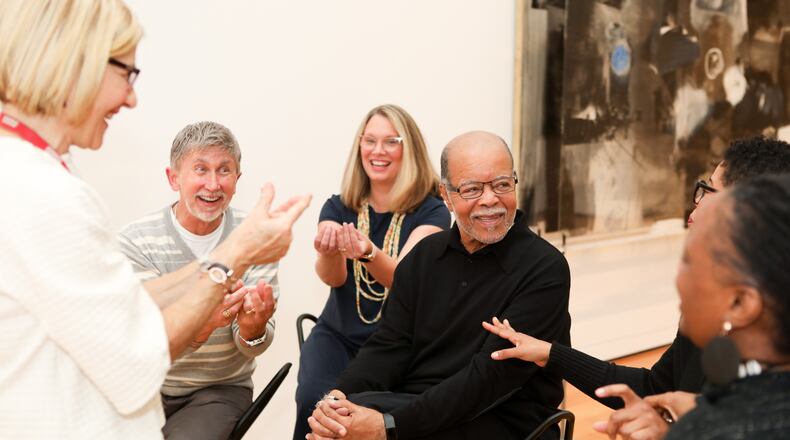When the High Museum of Art launched its Lifelong Learning program in February 2020, the intent was to help staunch the negative effects of social isolation on older adults. One month later, when the pandemic lockdown went into effect, people of all ages found themselves socially isolated and grappling with the fallout of being unable to see family and friends, commune in public or find joy through face-to-face camaraderie.
Fortunately, the Lifelong Learning connection was not lost. Like many other arts organizations, the High pivoted to online engagement and relaunched its in-person activities this month.
Credit: CatMax Photography LLC
Credit: CatMax Photography LLC
“It was a real wakeup call,” says Laurel Humble, head of the museum’s Creative Aging and Lifelong Learning department. “Being forced to shelter in place helped me empathize with people who were living in solitude owing to their life stage. It also gave me [and my colleagues on the Education staff] an opportunity to slow down, reset and listen to what people wanted and needed from the High.”
The initiative’s reboot — launched with a kickoff celebration June 1 — was made possible thanks to a variety of resources.
Research was funded by a community anchor grant from the Institute of Museum and Library Services. A collaborative effort with community partners, including AgeWell Atlanta and Georgia State University’s Project Healthy Grandparents, helped reimagine the ways in which art might be harnessed as a tool to process the world and connect with others.
The museum also formed a Lifelong Learning peer group called the Collective, a group of advisors, all 50 years old and above, who serve as ambassador consultants. They guide the museum on issues such as accessibility, community outreach and programming that would appeal to a broad cross section of Atlantans.
Maria Topalova relocated to Atlanta from Greece just over two years ago and found community in this program via the Zoom seminars on photography. She subsequently took classes in printing and art history, and looks forward to returning to in-person events in a space that’s consistently made her feel welcomed, appreciated and grateful.
“Getting to meet new people has been important to me and my husband, Kiril,” says Topalova. “The High’s programming not only kept us engaged during the pandemic . . . it gave us an opportunity to learn about the culture of the American South and helped us understand our local community through exposure to [regional] art history.”
Credit: CatMax Photography LLC
Credit: CatMax Photography LLC
Programs being offered this summer include Short Course Series, a four-week, immersive, discussion-based gathering; Inquiring Minds, an exploration of one of the High’s special exhibitions through small group conversation; Short-Course Studio, where participants will learn art techniques such as embroidery and textile design, figural sculpture making and found-object collage; and Studio Sessions, an art-making workshop focused on developing iconography while examining elements of art such as color, form and composition.
The Collective describes the initiative’s target demographic as “independent, active, curious, creative, resilient, involved and in search of intellectual/psycho/spiritual growth.” The Art and About Walking Tour series is specifically designed for this active and curious audience and taps into art happenings citywide. Whether observing mixed-media installations, sculpture or wall murals on the Beltline’s Eastside Trail or focusing on local architectural treasures, the goal is to foster learning, creativity and meaningful conversation through engagement with public art.
Docent-led tours provide lightweight collapsible stools and assistive listening devices in the galleries. Other accommodations such as wheelchairs are available.
Docent Bryan Brooks has seen the benefits of what he calls “slow looking” during sessions titled Conversation Pieces. Each monthly 30-minute conversation — offered virtually and in-person — focuses on a single artwork in the museum’s collection.
According to Brooks, who also serves as Southeast regional director for the National Docent Symposium Council, extending the drive-by window of 16 to 17 seconds that most visitors spend looking at a piece of art gives them an opportunity to notice and absorb details that might be lost otherwise.
“I have no idea what’s going through a person’s mind when they’re looking at a piece of art,” he says. “But the moment there’s a connection — a level of recognition and familiarity — it’s written all over their face. All of a sudden, their eyes will light up and twinkle!”
Brooks has noticed a concentration of “aha” moments in the museum’s folk art section, especially when visitors encounter the quilts from Gee’s Bend for the first time.
Adds Humble: “We’re all trying to find new experiences and places where we feel safe and welcome. I can’t think of a human alive who doesn’t have that as fundamental need. We want to open our doors, share what we have to offer and let everyone know that the High is a perfect place to be, a place to belong.”
For more information and to sign up for programs and classes, visit the High Museum of Art’s website at high.org.
Credit: ArtsATL
Credit: ArtsATL
MEET OUR PARTNER
ArtsATL (www.artsatl.org), is a nonprofit organization that plays a critical role in educating and informing audiences about metro Atlanta’s arts and culture. Founded in 2009, ArtsATL’s goal is to help build a sustainable arts community contributing to the economic and cultural health of the city.
If you have any questions about this partnership or others, please contact Senior Manager of Partnerships Nicole Williams at nicole.williams@ajc.com.
About the Author
The Latest
Featured





